Yoga's Impact: A Critical Analysis of Anxiety and Depression Studies
VerifiedAdded on 2022/12/28
|8
|2229
|1
Report
AI Summary
This report critically appraises a study by Javnbakht, Kenari & Ghasemi (2009) that investigated the effects of yoga on anxiety and depression in women. The study aimed to determine if yoga could alleviate symptoms of these conditions. A sample of 65 women were divided into experimental and control groups. The experimental group participated in yoga classes, while the control group did not. The study employed the Beck Depression Inventory and the State-Trait Anxiety Inventory to measure the impact of yoga. The findings indicated that yoga effectively reduced anxiety symptoms but showed less pronounced effects on depression, potentially due to the study's duration. The report evaluates the study's methodology, including data collection methods, and assesses the validity and reliability of the measurements. It identifies potential threats to internal and external validity, such as the limited sample size and single-gender focus, and suggests improvements for future research, including a more diverse and larger sample. The report concludes that while the study supports yoga's role in managing anxiety, further research is needed to fully understand its impact on depression.
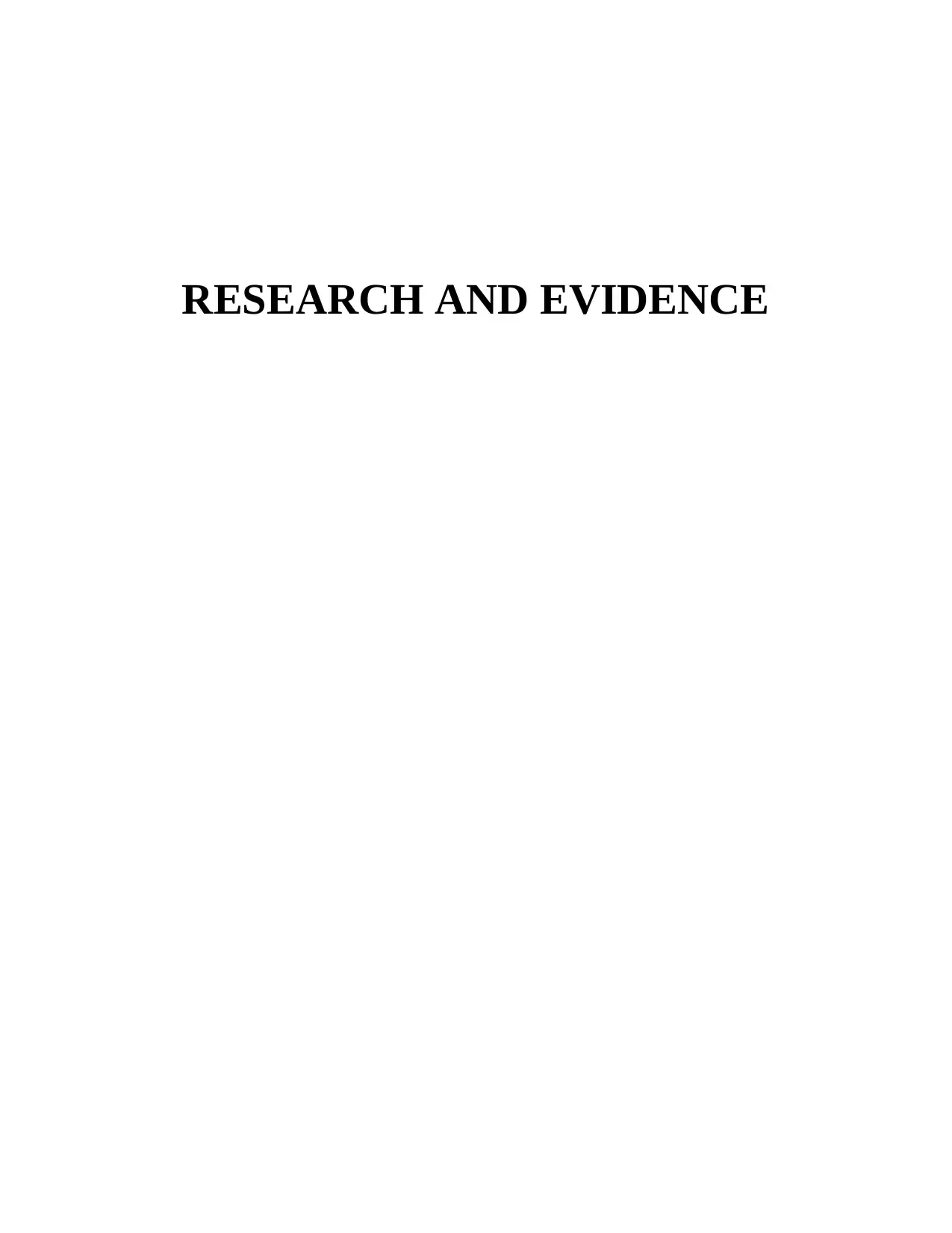
RESEARCH AND EVIDENCE
Paraphrase This Document
Need a fresh take? Get an instant paraphrase of this document with our AI Paraphraser

CRITICAL APPRASIAL
Introduction
The practice of yoga has been prevalent since ancient times and has co-existed along with
conventional treatments and medicine. Yoga has been considered as an ideal technique for
maintenance of healthy mind and body especially psychological cardiovascular and respiratory
related issues.
Aim
The aim of the study by Javnbakht, Kenari & Ghasemi (2009, p.102), is to discuss the
effectiveness of Yoga in managing or reduction of symptoms related to anxiety and depression in
women.
Hypothesis
H1: Yoga is effective in reducing symptoms of depression and anxiety.
Sample and recruitment
The sample for the study was randomly shortlisted new female patient according to personal
information questionnaire. The study excluded those having a history of psychiatric disorder,
drug abuse or have practiced yoga in their past. A sample size of 65 women were further divided
into experimental and control groups consisting of 34 and 31 women respectively to understand
the impact of yoga on mental wellbeing as well as reducing depression and anxiety.
Main findings and considerations
The study indicated that yoga was effective in decreasing symptoms of anxiety and supported the
findings of previous studies related to yoga by other scholars like Gupta (Gupta et al. 2006, p.41)
and Michalsen (Michalsen et al. 2005, p.555). The study also brought forward the fact that
treatment of depression through yoga will require a greater time period and longer exposure to
therapeutic yoga treatment. The study was in contrast with findings of Woolery (Woolery et al.
2004, p.63), since the sample shortlisted in his study had patients having mild depressive
disorder and not the severe ones. The study supported the use of yoga as a desirable technique
for bringing down the level of anxiety and with prolonged use is beneficial for mild to severe
levels of depression. Yoga techniques helped the individuals to understand their bodies’ thus
2
Introduction
The practice of yoga has been prevalent since ancient times and has co-existed along with
conventional treatments and medicine. Yoga has been considered as an ideal technique for
maintenance of healthy mind and body especially psychological cardiovascular and respiratory
related issues.
Aim
The aim of the study by Javnbakht, Kenari & Ghasemi (2009, p.102), is to discuss the
effectiveness of Yoga in managing or reduction of symptoms related to anxiety and depression in
women.
Hypothesis
H1: Yoga is effective in reducing symptoms of depression and anxiety.
Sample and recruitment
The sample for the study was randomly shortlisted new female patient according to personal
information questionnaire. The study excluded those having a history of psychiatric disorder,
drug abuse or have practiced yoga in their past. A sample size of 65 women were further divided
into experimental and control groups consisting of 34 and 31 women respectively to understand
the impact of yoga on mental wellbeing as well as reducing depression and anxiety.
Main findings and considerations
The study indicated that yoga was effective in decreasing symptoms of anxiety and supported the
findings of previous studies related to yoga by other scholars like Gupta (Gupta et al. 2006, p.41)
and Michalsen (Michalsen et al. 2005, p.555). The study also brought forward the fact that
treatment of depression through yoga will require a greater time period and longer exposure to
therapeutic yoga treatment. The study was in contrast with findings of Woolery (Woolery et al.
2004, p.63), since the sample shortlisted in his study had patients having mild depressive
disorder and not the severe ones. The study supported the use of yoga as a desirable technique
for bringing down the level of anxiety and with prolonged use is beneficial for mild to severe
levels of depression. Yoga techniques helped the individuals to understand their bodies’ thus
2

building self confidence in them and also bring a sense of control on personal levels
(Broughton,2016, p.20).
Summary of the measurement of the study
The method employed in the study included test according to Beck depression inventory which is
a reliable way of assessing intensity, depth and severity related to depression. The 21 item BDI
questionnaires were marked with scores to evaluate the intensity of scale of depression (Ediz,
Ozcakir & Bilgel, 2017, p.1283829). The high score indicated towards high intensity of
depression. The State-Trait Anxiety Inventory is helpful in measuring the state and trait anxiety
effectively (Renner et al. 2018, p.1409). The observations were conducted through method of
questionnaire proved to be highly efficient method in conducting the experiment over a period of
time. The participants shortlisted for the study were divided into experimental and control group
in order to understand the impact of yoga on levels of anxiety and depression. The data collected
was analysed with the help of T test and Wilcoxon test ruling out possibilities of any
discrepancies in calculating the data. The use latest software for the purpose of regression
analysis helped deriving just and valid results.
Methods of data collection
The method of data collection was quantitative research method which included personal
information questionnaires distributed to a group of 65 women for the segregated into control
and experimental group. The group was observed before the intervention of yoga therapy was
induced and again after a period of two months of undergoing yoga practices by experimental
group of women. The women in the control group observations were also monitor along with the
experimental groups.
Appropriate research methods were used to answer questions
Qualitative research method employed in the study was appropriate sunset and boy transforming
of numerical data collected from the control and experimental group into usable statistics (Nardi,
2018, p.275). The derived result was used for quantification of defined variables and the results
could be applied upon a larger population. The quantitative research method provided a
systematic investigation of the effectiveness of yoga on anxiety and depression and help in
3
(Broughton,2016, p.20).
Summary of the measurement of the study
The method employed in the study included test according to Beck depression inventory which is
a reliable way of assessing intensity, depth and severity related to depression. The 21 item BDI
questionnaires were marked with scores to evaluate the intensity of scale of depression (Ediz,
Ozcakir & Bilgel, 2017, p.1283829). The high score indicated towards high intensity of
depression. The State-Trait Anxiety Inventory is helpful in measuring the state and trait anxiety
effectively (Renner et al. 2018, p.1409). The observations were conducted through method of
questionnaire proved to be highly efficient method in conducting the experiment over a period of
time. The participants shortlisted for the study were divided into experimental and control group
in order to understand the impact of yoga on levels of anxiety and depression. The data collected
was analysed with the help of T test and Wilcoxon test ruling out possibilities of any
discrepancies in calculating the data. The use latest software for the purpose of regression
analysis helped deriving just and valid results.
Methods of data collection
The method of data collection was quantitative research method which included personal
information questionnaires distributed to a group of 65 women for the segregated into control
and experimental group. The group was observed before the intervention of yoga therapy was
induced and again after a period of two months of undergoing yoga practices by experimental
group of women. The women in the control group observations were also monitor along with the
experimental groups.
Appropriate research methods were used to answer questions
Qualitative research method employed in the study was appropriate sunset and boy transforming
of numerical data collected from the control and experimental group into usable statistics (Nardi,
2018, p.275). The derived result was used for quantification of defined variables and the results
could be applied upon a larger population. The quantitative research method provided a
systematic investigation of the effectiveness of yoga on anxiety and depression and help in
3
⊘ This is a preview!⊘
Do you want full access?
Subscribe today to unlock all pages.

Trusted by 1+ million students worldwide
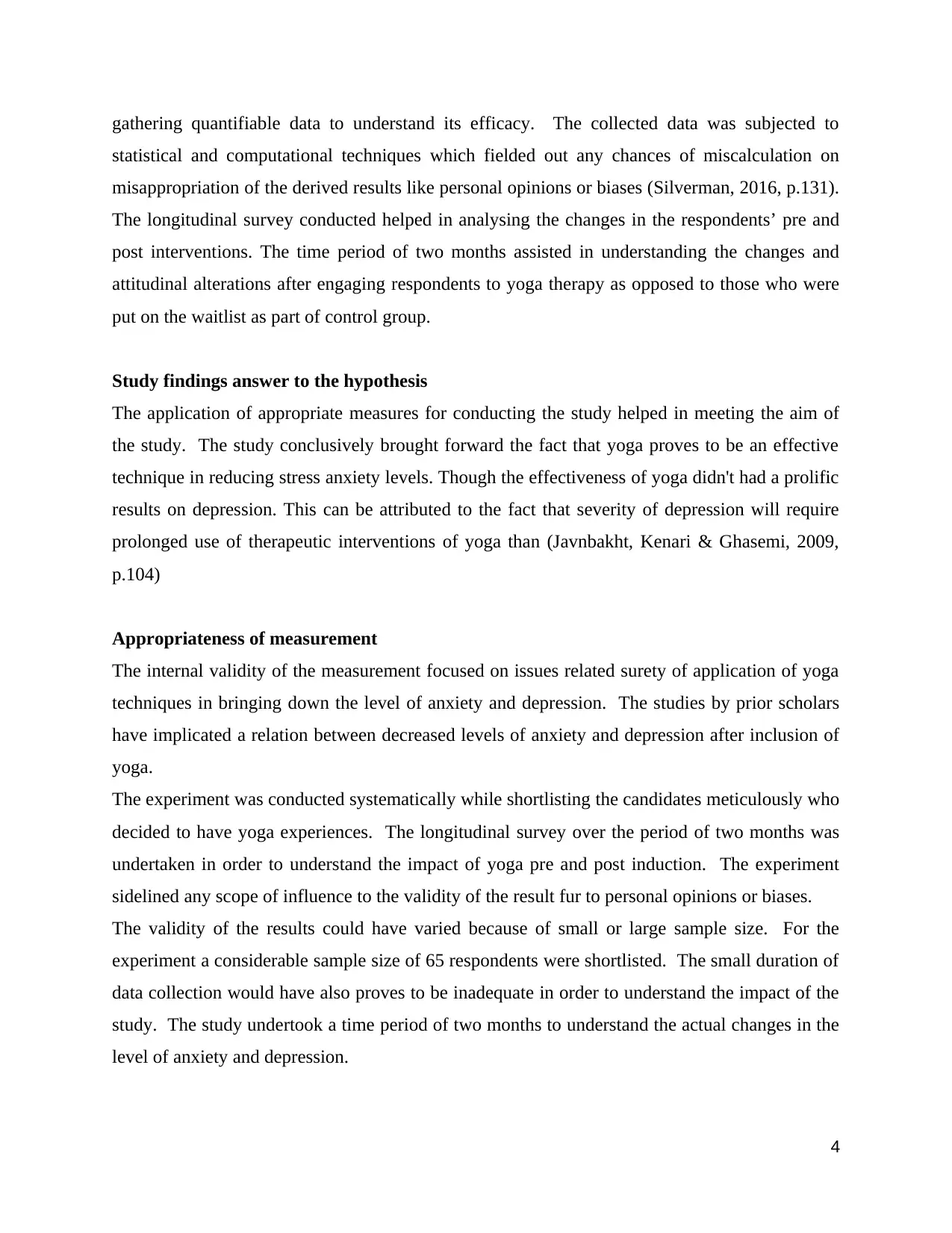
gathering quantifiable data to understand its efficacy. The collected data was subjected to
statistical and computational techniques which fielded out any chances of miscalculation on
misappropriation of the derived results like personal opinions or biases (Silverman, 2016, p.131).
The longitudinal survey conducted helped in analysing the changes in the respondents’ pre and
post interventions. The time period of two months assisted in understanding the changes and
attitudinal alterations after engaging respondents to yoga therapy as opposed to those who were
put on the waitlist as part of control group.
Study findings answer to the hypothesis
The application of appropriate measures for conducting the study helped in meeting the aim of
the study. The study conclusively brought forward the fact that yoga proves to be an effective
technique in reducing stress anxiety levels. Though the effectiveness of yoga didn't had a prolific
results on depression. This can be attributed to the fact that severity of depression will require
prolonged use of therapeutic interventions of yoga than (Javnbakht, Kenari & Ghasemi, 2009,
p.104)
Appropriateness of measurement
The internal validity of the measurement focused on issues related surety of application of yoga
techniques in bringing down the level of anxiety and depression. The studies by prior scholars
have implicated a relation between decreased levels of anxiety and depression after inclusion of
yoga.
The experiment was conducted systematically while shortlisting the candidates meticulously who
decided to have yoga experiences. The longitudinal survey over the period of two months was
undertaken in order to understand the impact of yoga pre and post induction. The experiment
sidelined any scope of influence to the validity of the result fur to personal opinions or biases.
The validity of the results could have varied because of small or large sample size. For the
experiment a considerable sample size of 65 respondents were shortlisted. The small duration of
data collection would have also proves to be inadequate in order to understand the impact of the
study. The study undertook a time period of two months to understand the actual changes in the
level of anxiety and depression.
4
statistical and computational techniques which fielded out any chances of miscalculation on
misappropriation of the derived results like personal opinions or biases (Silverman, 2016, p.131).
The longitudinal survey conducted helped in analysing the changes in the respondents’ pre and
post interventions. The time period of two months assisted in understanding the changes and
attitudinal alterations after engaging respondents to yoga therapy as opposed to those who were
put on the waitlist as part of control group.
Study findings answer to the hypothesis
The application of appropriate measures for conducting the study helped in meeting the aim of
the study. The study conclusively brought forward the fact that yoga proves to be an effective
technique in reducing stress anxiety levels. Though the effectiveness of yoga didn't had a prolific
results on depression. This can be attributed to the fact that severity of depression will require
prolonged use of therapeutic interventions of yoga than (Javnbakht, Kenari & Ghasemi, 2009,
p.104)
Appropriateness of measurement
The internal validity of the measurement focused on issues related surety of application of yoga
techniques in bringing down the level of anxiety and depression. The studies by prior scholars
have implicated a relation between decreased levels of anxiety and depression after inclusion of
yoga.
The experiment was conducted systematically while shortlisting the candidates meticulously who
decided to have yoga experiences. The longitudinal survey over the period of two months was
undertaken in order to understand the impact of yoga pre and post induction. The experiment
sidelined any scope of influence to the validity of the result fur to personal opinions or biases.
The validity of the results could have varied because of small or large sample size. For the
experiment a considerable sample size of 65 respondents were shortlisted. The small duration of
data collection would have also proves to be inadequate in order to understand the impact of the
study. The study undertook a time period of two months to understand the actual changes in the
level of anxiety and depression.
4
Paraphrase This Document
Need a fresh take? Get an instant paraphrase of this document with our AI Paraphraser
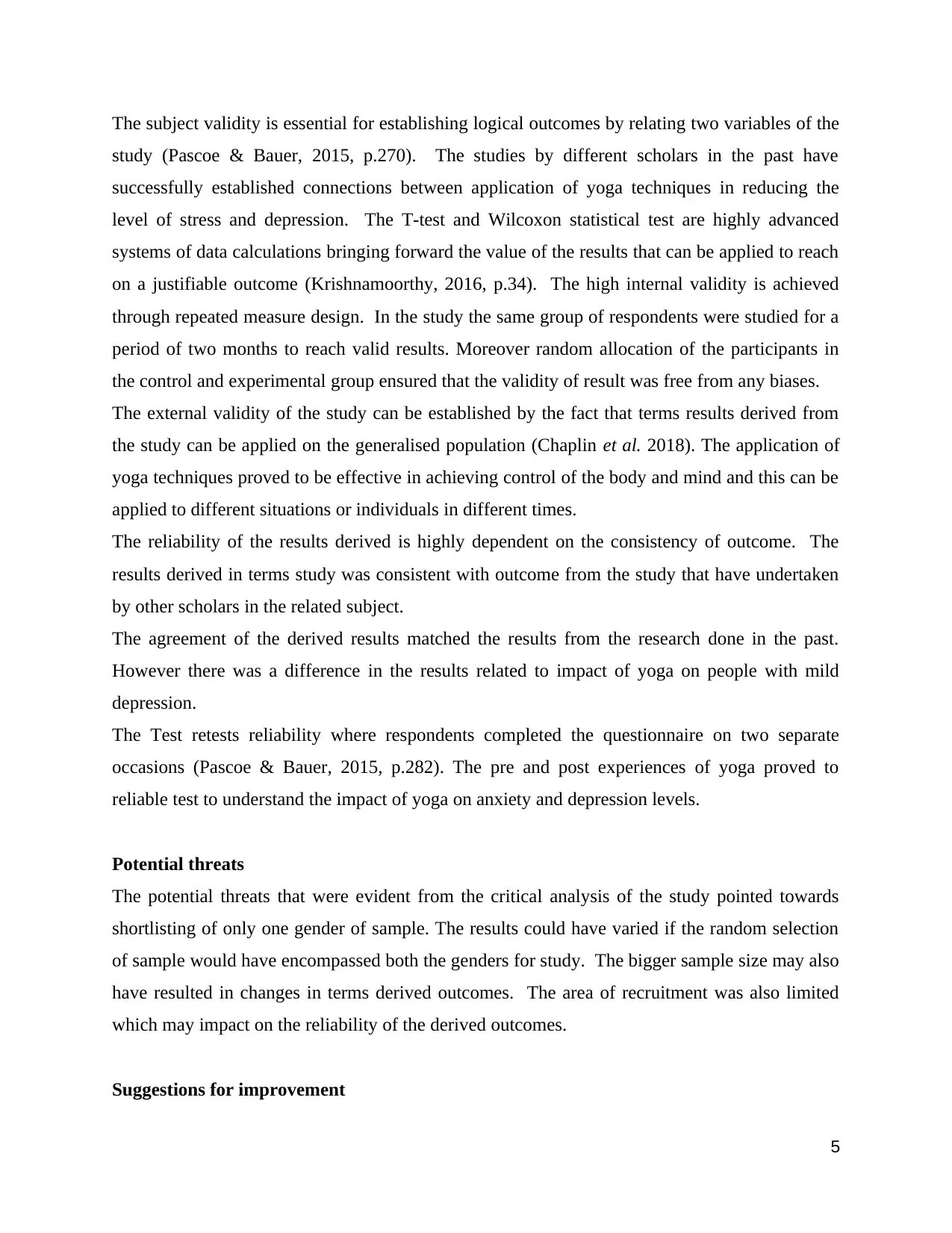
The subject validity is essential for establishing logical outcomes by relating two variables of the
study (Pascoe & Bauer, 2015, p.270). The studies by different scholars in the past have
successfully established connections between application of yoga techniques in reducing the
level of stress and depression. The T-test and Wilcoxon statistical test are highly advanced
systems of data calculations bringing forward the value of the results that can be applied to reach
on a justifiable outcome (Krishnamoorthy, 2016, p.34). The high internal validity is achieved
through repeated measure design. In the study the same group of respondents were studied for a
period of two months to reach valid results. Moreover random allocation of the participants in
the control and experimental group ensured that the validity of result was free from any biases.
The external validity of the study can be established by the fact that terms results derived from
the study can be applied on the generalised population (Chaplin et al. 2018). The application of
yoga techniques proved to be effective in achieving control of the body and mind and this can be
applied to different situations or individuals in different times.
The reliability of the results derived is highly dependent on the consistency of outcome. The
results derived in terms study was consistent with outcome from the study that have undertaken
by other scholars in the related subject.
The agreement of the derived results matched the results from the research done in the past.
However there was a difference in the results related to impact of yoga on people with mild
depression.
The Test retests reliability where respondents completed the questionnaire on two separate
occasions (Pascoe & Bauer, 2015, p.282). The pre and post experiences of yoga proved to
reliable test to understand the impact of yoga on anxiety and depression levels.
Potential threats
The potential threats that were evident from the critical analysis of the study pointed towards
shortlisting of only one gender of sample. The results could have varied if the random selection
of sample would have encompassed both the genders for study. The bigger sample size may also
have resulted in changes in terms derived outcomes. The area of recruitment was also limited
which may impact on the reliability of the derived outcomes.
Suggestions for improvement
5
study (Pascoe & Bauer, 2015, p.270). The studies by different scholars in the past have
successfully established connections between application of yoga techniques in reducing the
level of stress and depression. The T-test and Wilcoxon statistical test are highly advanced
systems of data calculations bringing forward the value of the results that can be applied to reach
on a justifiable outcome (Krishnamoorthy, 2016, p.34). The high internal validity is achieved
through repeated measure design. In the study the same group of respondents were studied for a
period of two months to reach valid results. Moreover random allocation of the participants in
the control and experimental group ensured that the validity of result was free from any biases.
The external validity of the study can be established by the fact that terms results derived from
the study can be applied on the generalised population (Chaplin et al. 2018). The application of
yoga techniques proved to be effective in achieving control of the body and mind and this can be
applied to different situations or individuals in different times.
The reliability of the results derived is highly dependent on the consistency of outcome. The
results derived in terms study was consistent with outcome from the study that have undertaken
by other scholars in the related subject.
The agreement of the derived results matched the results from the research done in the past.
However there was a difference in the results related to impact of yoga on people with mild
depression.
The Test retests reliability where respondents completed the questionnaire on two separate
occasions (Pascoe & Bauer, 2015, p.282). The pre and post experiences of yoga proved to
reliable test to understand the impact of yoga on anxiety and depression levels.
Potential threats
The potential threats that were evident from the critical analysis of the study pointed towards
shortlisting of only one gender of sample. The results could have varied if the random selection
of sample would have encompassed both the genders for study. The bigger sample size may also
have resulted in changes in terms derived outcomes. The area of recruitment was also limited
which may impact on the reliability of the derived outcomes.
Suggestions for improvement
5
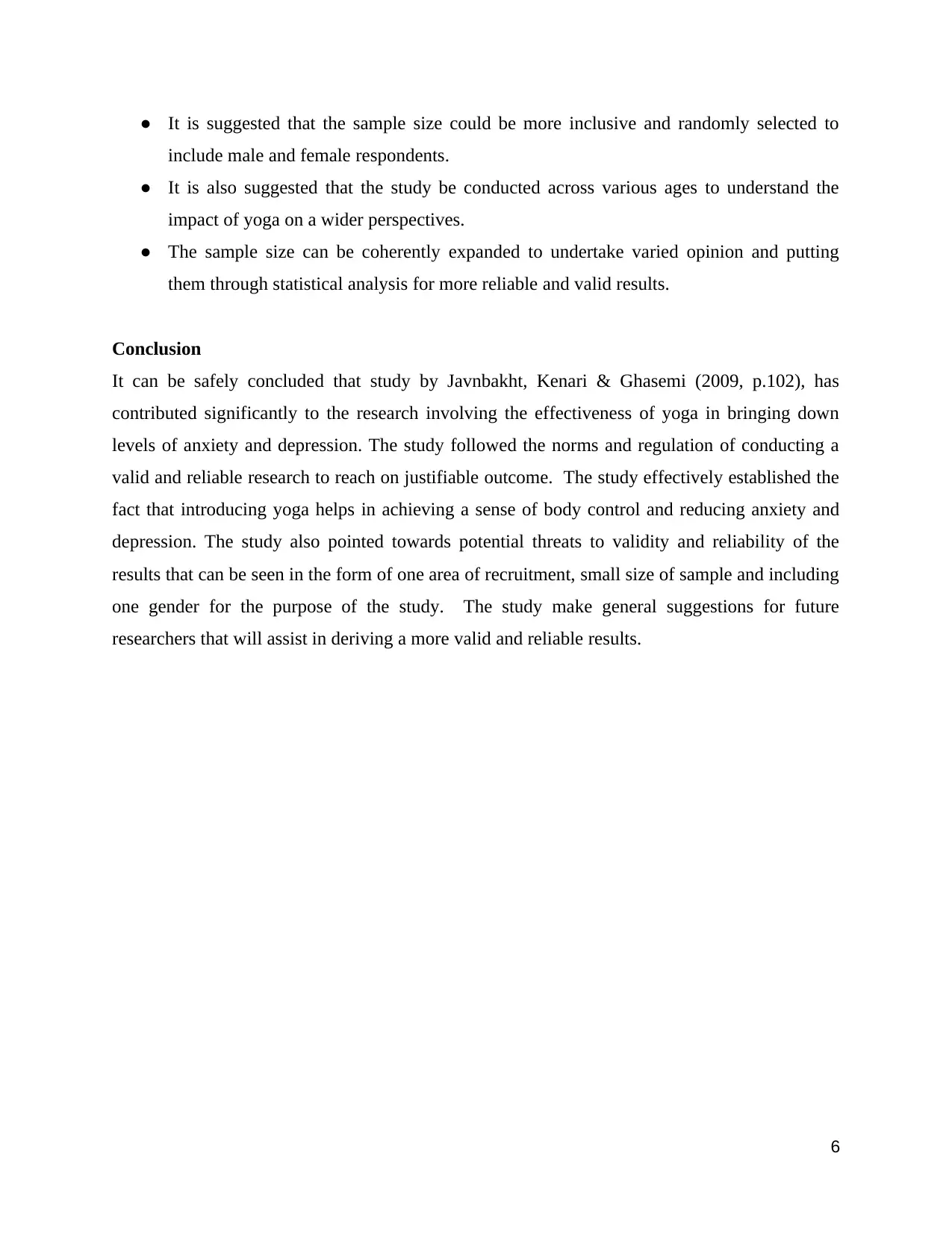
● It is suggested that the sample size could be more inclusive and randomly selected to
include male and female respondents.
● It is also suggested that the study be conducted across various ages to understand the
impact of yoga on a wider perspectives.
● The sample size can be coherently expanded to undertake varied opinion and putting
them through statistical analysis for more reliable and valid results.
Conclusion
It can be safely concluded that study by Javnbakht, Kenari & Ghasemi (2009, p.102), has
contributed significantly to the research involving the effectiveness of yoga in bringing down
levels of anxiety and depression. The study followed the norms and regulation of conducting a
valid and reliable research to reach on justifiable outcome. The study effectively established the
fact that introducing yoga helps in achieving a sense of body control and reducing anxiety and
depression. The study also pointed towards potential threats to validity and reliability of the
results that can be seen in the form of one area of recruitment, small size of sample and including
one gender for the purpose of the study. The study make general suggestions for future
researchers that will assist in deriving a more valid and reliable results.
6
include male and female respondents.
● It is also suggested that the study be conducted across various ages to understand the
impact of yoga on a wider perspectives.
● The sample size can be coherently expanded to undertake varied opinion and putting
them through statistical analysis for more reliable and valid results.
Conclusion
It can be safely concluded that study by Javnbakht, Kenari & Ghasemi (2009, p.102), has
contributed significantly to the research involving the effectiveness of yoga in bringing down
levels of anxiety and depression. The study followed the norms and regulation of conducting a
valid and reliable research to reach on justifiable outcome. The study effectively established the
fact that introducing yoga helps in achieving a sense of body control and reducing anxiety and
depression. The study also pointed towards potential threats to validity and reliability of the
results that can be seen in the form of one area of recruitment, small size of sample and including
one gender for the purpose of the study. The study make general suggestions for future
researchers that will assist in deriving a more valid and reliable results.
6
⊘ This is a preview!⊘
Do you want full access?
Subscribe today to unlock all pages.

Trusted by 1+ million students worldwide
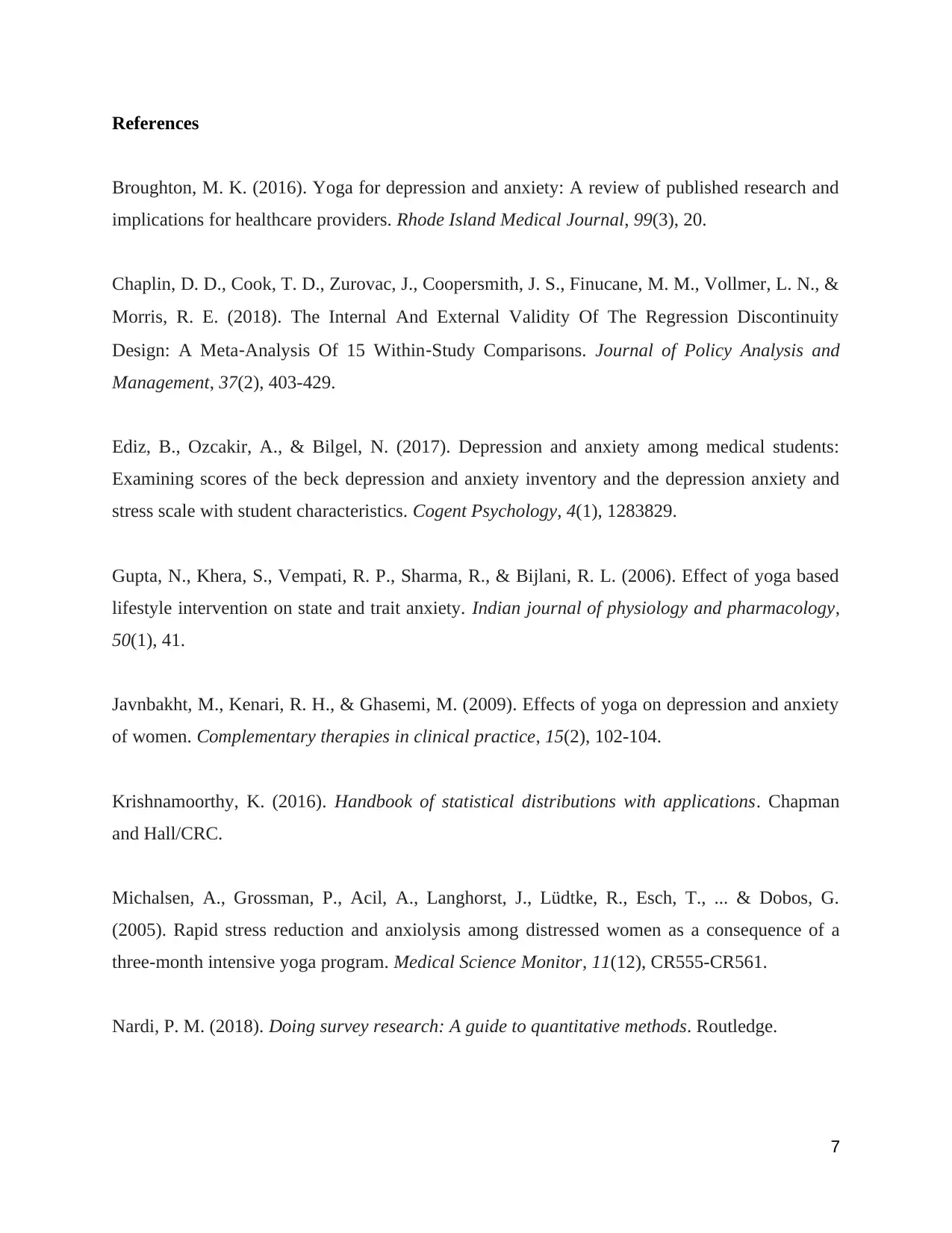
References
Broughton, M. K. (2016). Yoga for depression and anxiety: A review of published research and
implications for healthcare providers. Rhode Island Medical Journal, 99(3), 20.
Chaplin, D. D., Cook, T. D., Zurovac, J., Coopersmith, J. S., Finucane, M. M., Vollmer, L. N., &
Morris, R. E. (2018). The Internal And External Validity Of The Regression Discontinuity
Design: A Meta‐Analysis Of 15 Within‐Study Comparisons. Journal of Policy Analysis and
Management, 37(2), 403-429.
Ediz, B., Ozcakir, A., & Bilgel, N. (2017). Depression and anxiety among medical students:
Examining scores of the beck depression and anxiety inventory and the depression anxiety and
stress scale with student characteristics. Cogent Psychology, 4(1), 1283829.
Gupta, N., Khera, S., Vempati, R. P., Sharma, R., & Bijlani, R. L. (2006). Effect of yoga based
lifestyle intervention on state and trait anxiety. Indian journal of physiology and pharmacology,
50(1), 41.
Javnbakht, M., Kenari, R. H., & Ghasemi, M. (2009). Effects of yoga on depression and anxiety
of women. Complementary therapies in clinical practice, 15(2), 102-104.
Krishnamoorthy, K. (2016). Handbook of statistical distributions with applications. Chapman
and Hall/CRC.
Michalsen, A., Grossman, P., Acil, A., Langhorst, J., Lüdtke, R., Esch, T., ... & Dobos, G.
(2005). Rapid stress reduction and anxiolysis among distressed women as a consequence of a
three-month intensive yoga program. Medical Science Monitor, 11(12), CR555-CR561.
Nardi, P. M. (2018). Doing survey research: A guide to quantitative methods. Routledge.
7
Broughton, M. K. (2016). Yoga for depression and anxiety: A review of published research and
implications for healthcare providers. Rhode Island Medical Journal, 99(3), 20.
Chaplin, D. D., Cook, T. D., Zurovac, J., Coopersmith, J. S., Finucane, M. M., Vollmer, L. N., &
Morris, R. E. (2018). The Internal And External Validity Of The Regression Discontinuity
Design: A Meta‐Analysis Of 15 Within‐Study Comparisons. Journal of Policy Analysis and
Management, 37(2), 403-429.
Ediz, B., Ozcakir, A., & Bilgel, N. (2017). Depression and anxiety among medical students:
Examining scores of the beck depression and anxiety inventory and the depression anxiety and
stress scale with student characteristics. Cogent Psychology, 4(1), 1283829.
Gupta, N., Khera, S., Vempati, R. P., Sharma, R., & Bijlani, R. L. (2006). Effect of yoga based
lifestyle intervention on state and trait anxiety. Indian journal of physiology and pharmacology,
50(1), 41.
Javnbakht, M., Kenari, R. H., & Ghasemi, M. (2009). Effects of yoga on depression and anxiety
of women. Complementary therapies in clinical practice, 15(2), 102-104.
Krishnamoorthy, K. (2016). Handbook of statistical distributions with applications. Chapman
and Hall/CRC.
Michalsen, A., Grossman, P., Acil, A., Langhorst, J., Lüdtke, R., Esch, T., ... & Dobos, G.
(2005). Rapid stress reduction and anxiolysis among distressed women as a consequence of a
three-month intensive yoga program. Medical Science Monitor, 11(12), CR555-CR561.
Nardi, P. M. (2018). Doing survey research: A guide to quantitative methods. Routledge.
7
Paraphrase This Document
Need a fresh take? Get an instant paraphrase of this document with our AI Paraphraser
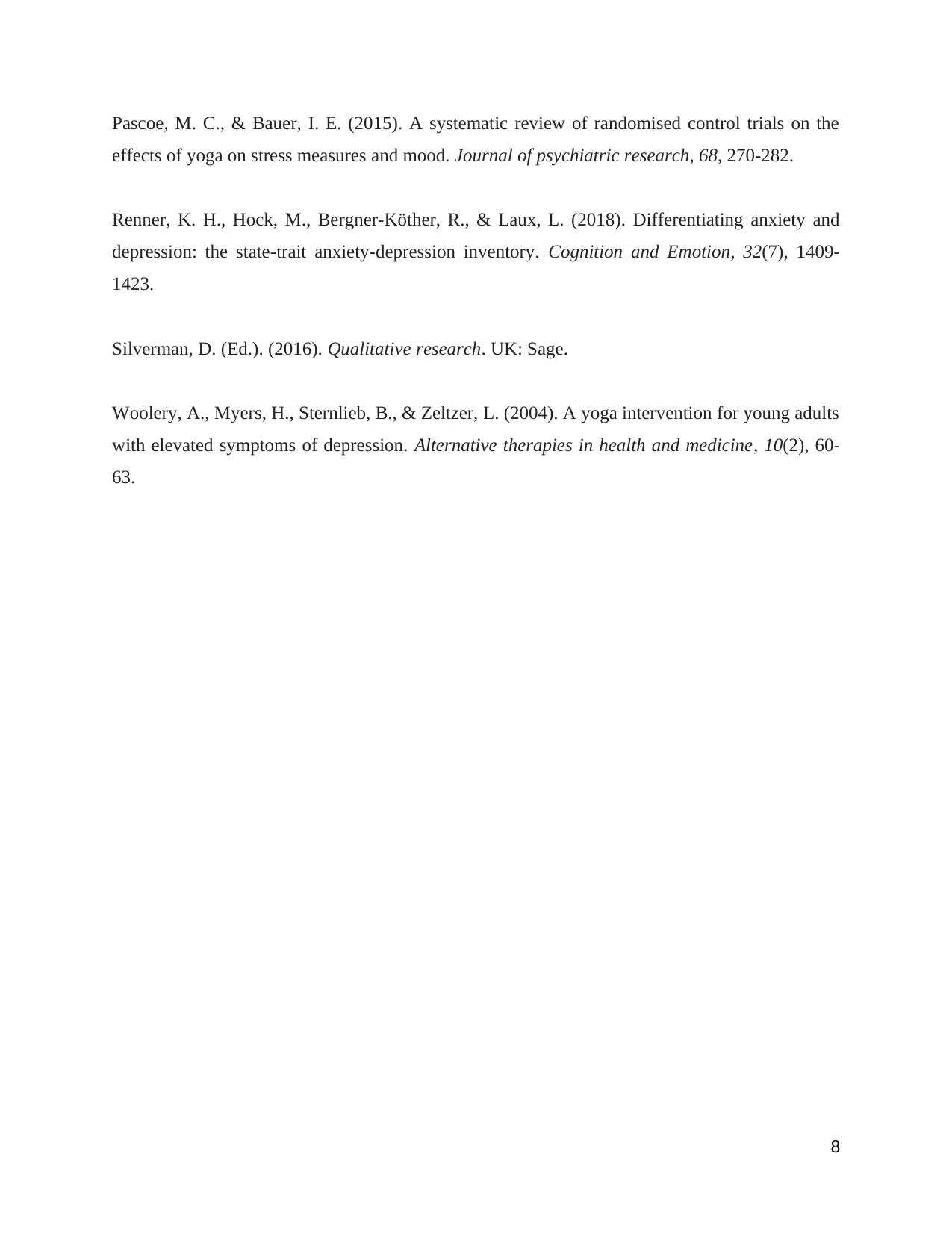
Pascoe, M. C., & Bauer, I. E. (2015). A systematic review of randomised control trials on the
effects of yoga on stress measures and mood. Journal of psychiatric research, 68, 270-282.
Renner, K. H., Hock, M., Bergner-Köther, R., & Laux, L. (2018). Differentiating anxiety and
depression: the state-trait anxiety-depression inventory. Cognition and Emotion, 32(7), 1409-
1423.
Silverman, D. (Ed.). (2016). Qualitative research. UK: Sage.
Woolery, A., Myers, H., Sternlieb, B., & Zeltzer, L. (2004). A yoga intervention for young adults
with elevated symptoms of depression. Alternative therapies in health and medicine, 10(2), 60-
63.
8
effects of yoga on stress measures and mood. Journal of psychiatric research, 68, 270-282.
Renner, K. H., Hock, M., Bergner-Köther, R., & Laux, L. (2018). Differentiating anxiety and
depression: the state-trait anxiety-depression inventory. Cognition and Emotion, 32(7), 1409-
1423.
Silverman, D. (Ed.). (2016). Qualitative research. UK: Sage.
Woolery, A., Myers, H., Sternlieb, B., & Zeltzer, L. (2004). A yoga intervention for young adults
with elevated symptoms of depression. Alternative therapies in health and medicine, 10(2), 60-
63.
8
1 out of 8
Related Documents
Your All-in-One AI-Powered Toolkit for Academic Success.
+13062052269
info@desklib.com
Available 24*7 on WhatsApp / Email
![[object Object]](/_next/static/media/star-bottom.7253800d.svg)
Unlock your academic potential
Copyright © 2020–2025 A2Z Services. All Rights Reserved. Developed and managed by ZUCOL.





